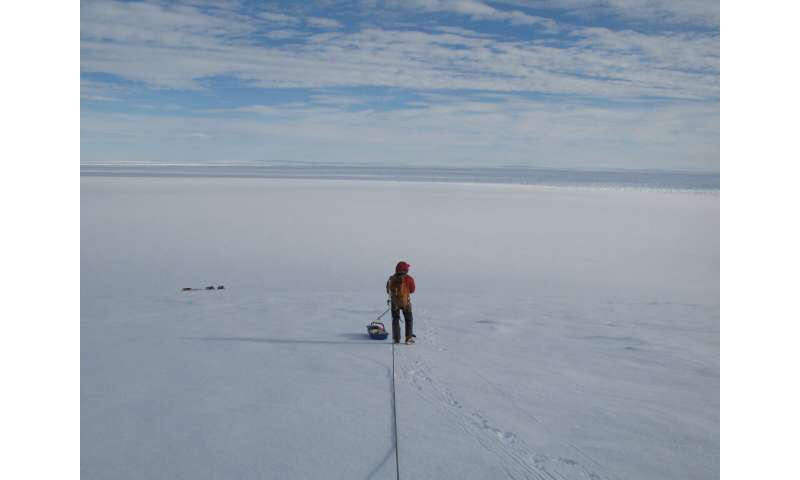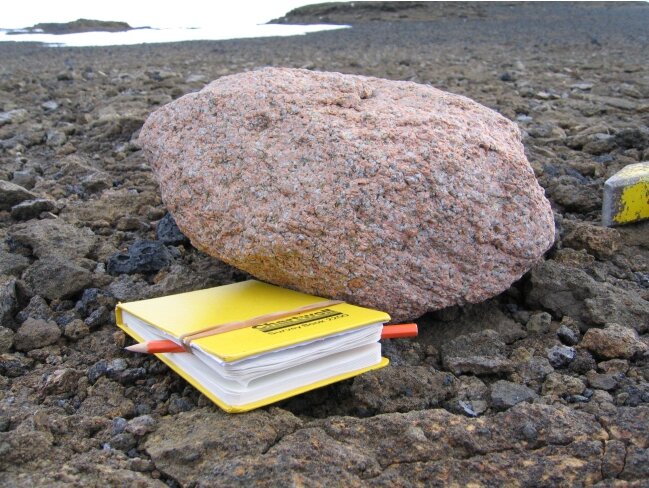
A pink granite boulder next to a yellow notebook for scale. Credit: Jo Johnson, BAS
Pink granite boulders scattered across the dark volcanic peaks of the Hudson Mountains in West Antarctica, have revealed the presence of a vast buried granite body—almost 100 km across and 7 km thick, about half the size of Wales in the UK—beneath Pine Island Glacier.
The unusual boulders, perched high in the mountains, have puzzled scientists for decades. Where did they come from, and what could they reveal about the ice sheet’s past and future?
A team of researchers, led by British Antarctic Survey (BAS), dated the granites using the radioactive decay of elements locked within microscopic crystals, discovering that the rocks formed around 175 million years ago, during the Jurassic period. But how the boulders came to rest in these mountains remained mysterious until new evidence came from airborne surveys. The study is published in the journal Communications Earth & Environment.
Precise gravity measurements collected by the BAS’ Twin Otter and other aircraft flying over the region revealed an unusual geological signal from beneath the glacier, matching the signature expected from a buried granite.
Linking the scattered boulders with this hidden giant granite has provided a breakthrough. It not only solves a long-standing geological puzzle but also offers vital clues to how Pine Island Glacier behaved in the past, plucking rocks from the bed and depositing them on the mountains at a time when the ice sheet was much thicker. Understanding the ice thickness and flow regimes during the last ice age (around 20 thousand years ago) helps scientists refine ice sheet computer models, which are critical for predicting how Antarctica will respond to future climate change.
-

Credit: Jo Johnson, BAS
-

Twin Otters carried out survey work in West Antarctica. Credit: BAS.
Dr. Tom Jordan, lead author and geophysicist at BAS, analyzed the airborne survey data. He said, “It’s remarkable that pink granite boulders spotted on the surface have led us to a hidden giant beneath the ice. By combining geological dating with gravity surveys, we’ve not only solved a mystery about where these rocks came from, but also uncovered new information about how the ice sheet flowed in the past and how it might change in the future.”
The discovery also sheds light on present-day processes. Beneath Pine Island Glacier, a region that has seen some of the fastest ice loss in Antarctica in the last few decades, the geology strongly influences how ice slides over the bed and how meltwater drains beneath it. The new findings will help improve computer models of ice flow that are used to project sea level rise.
Dr. Joanne Johnson, a co-author on the study and a geologist at BAS, collected the rocks during fieldwork around the Hudson Mountains as part of the International Thwaites Glacier Collaboration. She says, “Rocks provide an amazing record of how our planet has changed over time, especially how ice has eroded and altered the landscape of Antarctica. Boulders like these are a treasure trove of information about what lies deep beneath the ice sheet, far out of reach.
“By identifying their source, we have been able to piece together how they got to where they are today, giving us clues about how the West Antarctic Ice Sheet may change in future—information that is vital for determining the impact of sea level rise on coastal populations around the world.”
This study highlights how combining different strands of science, in this case, geology and geophysics, can provide new insights into the hidden processes shaping our planet.
More information:
Tom A. Jordan et al, Subglacial geology and palaeo flow of Pine Island Glacier from combining glacial erratics with geophysics, Communications Earth & Environment (2025). DOI: 10.1038/s43247-025-02783-3
Provided by
British Antarctic Survey
Citation:
Hidden giant granite discovered beneath West Antarctic Ice Sheet (2025, October 22)
retrieved 22 October 2025
from https://phys.org/news/2025-10-hidden-giant-granite-beneath-west.html
This document is subject to copyright. Apart from any fair dealing for the purpose of private study or research, no
part may be reproduced without the written permission. The content is provided for information purposes only.
